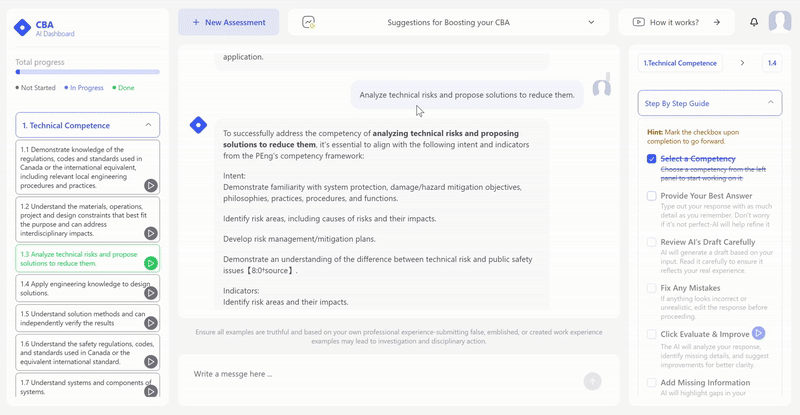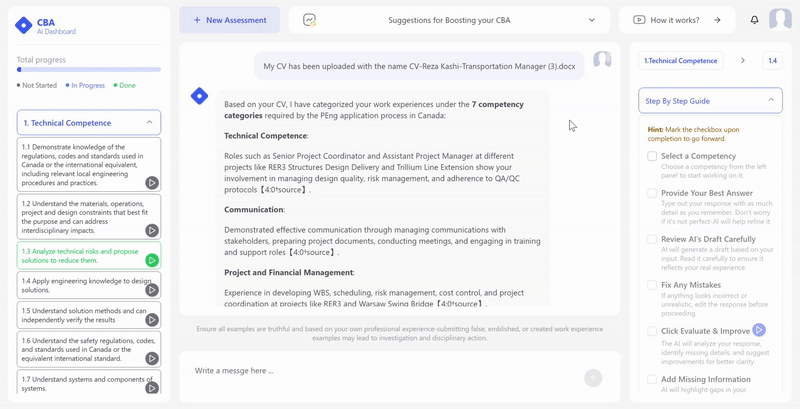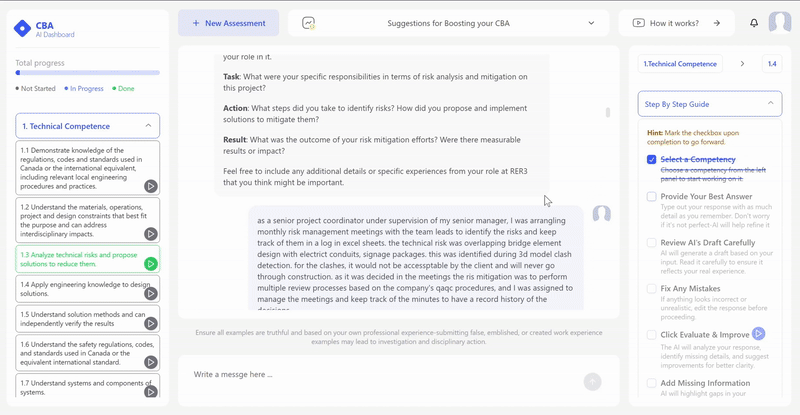Writing your Competency-Based Assessment (CBA) can feel like one of the most daunting steps on the path to becoming a licensed Professional Engineer (P.Eng.) in Canada. For many applicants, the challenge isn’t just about recalling their engineering experience—it’s about effectively communicating it in a way that meets strict assessment criteria. If you’re feeling unsure where to begin or how to structure your submission, you’re not alone.
In this blog, we’ll walk you through how to write CBA in a clear, focused, and compelling way. You’ll learn how to match your experience with association’s requirements (i.e., PEO’s 34 competencies, APEGA‘s 22 competencies, etc.) choose appropriate validators, and apply the proven Situation-Action-Outcome (SAO) framework that assessors love to see. Whether you’re an internationally trained engineer or an EIT with Canadian experience, this guide will help you craft CBA responses that highlight your readiness for professional licensure.
Your CBA isn’t just a form—it’s your professional story. By learning how to write CBA strategically, you’re not only meeting a licensing requirement, but also showcasing the depth and value of your engineering journey.
What is the CBA and Why Does Writing Matter?
Understanding the Purpose of CBA
The Competency-Based Assessment (CBA) is the cornerstone of the engineering licensure process in Ontario and many other Canadian provinces. It’s not just about proving that you’ve worked in engineering—it’s about demonstrating that you’ve developed and can apply professional competencies required to practice safely, ethically, and independently as a Professional Engineer.
At its core, CBA evaluates your experience across 22 to 34 key competencies (varies depending on the association), grouped under seven categories, including Technical Competence, Communication, Project Management, and Professional Accountability. These competencies are designed to ensure that your experience aligns with both Canadian engineering standards and public safety expectations.
For instance, the PEng CBA assessors look for your ability to:
-
Apply technical knowledge in real-world settings
-
Communicate effectively with technical and non-technical stakeholders
-
Understand ethical obligations and regulatory frameworks
-
Show leadership and growth over time
The better you understand what each competency represents, the more precise and relevant your examples will be.
Why Your Writing Style Can Make or Break the Submission
Writing your CBA is not just a box-ticking exercise—it’s your chance to stand out as a competent and ethical engineering professional. While the technical depth of your experience is essential, how you communicate that experience is equally important.
Assessors are evaluating your submission for:
-
Clarity of your role and responsibilities
-
Relevance of the work to the competency
-
Independent thinking and decision-making
-
Outcomes and impacts of your actions
A poorly written CBA can underrepresent great experience. For example:
-
Vague statements like “I helped the team with design” won’t cut it.
-
Overly technical jargon without context might confuse the assessors.
-
Missing the “why it mattered” makes even good examples fall flat.
Remember, this is not a technical report—it’s a competency narrative. Your writing should reflect your thought process, judgment, and leadership.
Before You Start Writing
Before diving into writing your Competency-Based Assessment, take a strategic pause. The difference between a smooth CBA experience and a frustrating rewrite often comes down to how well you prepare before you write. This section will walk you through essential groundwork that sets your CBA submission up for success.
Read the Full List of 34 Competencies
The first step in understanding how to write CBA effectively is knowing exactly what you’re being evaluated on. The CBA system evaluates you across 34 competencies grouped into 7 categories:
-
Technical Competence
-
Communication
-
Project and Financial Management
-
Team Effectiveness
-
Professional Accountability
-
Social, Economic, Environmental & Sustainability
-
Personal Continuing Professional Development
Each competency has detailed descriptions and indicators. These are examples of typical engineering tasks that demonstrate you’ve mastered that skill. Indicators are not checklists, but they help you select and tailor your examples appropriately. Explore the full list of your association guideline here.
CBA Pro provides detailed explanation over the competencies and indicators. It also provides you with personalized example of how such a competency with a person with similar background like you would look like.

Match Your Experience with the Right Competencies
While some experiences can apply to multiple competencies, each write-up should be customized to reflect what the specific competency asks for. For example:
-
For Technical Competence, emphasize engineering calculations, code compliance, and risk analysis.
-
For Communication, highlight how you explained ideas to clients, wrote reports, or gave presentations.
-
For Professional Accountability, focus on ethics, decision-making, and code of conduct.
Use the indicators in the CBA guide as writing prompts. Think of them as clues that help you reflect on your experience in the right way.
You likely have more experience than you think, but choosing the right examples for the right competencies is key. Here’s how to approach it:
- Scan all 34 competencies and highlight the ones you feel confident in.
- List 1–2 strong project examples for each competency.
- Group similar experiences to reduce overlap in writing (some examples can be used across multiple competencies with proper tailoring).
Use a spreadsheet to track which experiences you’ll use for which competencies. CertNova’s CBA Pro tool makes this process even easier by helping you map your experience and identify gaps early.

CBA Pro simplifies how you write your CBA by guiding you through each of the competencies step by step. It helps you:
-
Map your engineering experience to the right competencies
-
Match your examples to the indicators for better clarity
-
Spot gaps in your submission before you send it
With CBA Pro, you’re not guessing—you’re submitting with confidence.
How to Structure Your Work Examples
Writing clear and impactful examples is the heart of your CBA submission. Even if your engineering experience is strong, poor structure or vague storytelling can cause assessors to question your competence. That’s why understanding the Situation-Action-Outcome (SAO) framework is critical when learning how to write CBA effectively.
The Situation-Action-Outcome (SAO) Framework
This three-part format is the gold standard for CBA writing. It keeps your examples focused, easy to follow, and aligned with how assessors evaluate performance.
Here’s how to break it down:
-
Situation: Set the stage. What project were you working on? What was the problem, challenge, or goal? Be concise but give enough context for someone unfamiliar with your role to understand.
-
Action: This is the most important part. What you did matters most. Highlight your engineering decisions, tools, processes, and reasoning. Use “I” statements and focus on your independent contributions—not just what the team did.
-
Outcome: What was the result? Mention impact, improvements, savings, risk mitigation, or any feedback received. Quantify results where possible.
Example:
“I led the redesign of a stormwater drainage system that had failed during peak flow. I performed hydraulic simulations, adjusted pipe slopes, and worked with the municipality for approvals. The updated system reduced flooding incidents by 85% during heavy rainfall events.”
CBA Pro collects all the necessary information from you through Q&A interview style based on the CBA guidelines and structures it into the SAO format.

Writing Tips to Maximize Your Ratings
Once your structure is solid, it’s time to refine your writing. The way you communicate your engineering experience plays a big role in how assessors rate each competency. Even if your technical work is strong, vague, overly complex, or passive writing can lower your ratings.
Here’s how to sharpen your CBA examples and increase your chances of scoring high:
Use “I” Statements to Show Ownership
Assessors want to see what you did—not what the team or company accomplished. Avoid phrases like “The team developed a solution…” or “We were responsible for…” Instead, be assertive and specific.
-
❌ “We improved the system design to meet new standards.”
-
✅ “I redesigned the system based on updated CSA codes and led the review with our senior engineer.”
This not only shows leadership but also clarifies your individual impact, which is key to a high score.
Include Technical Details Without Overloading
Yes, you need to show technical depth—but don’t fall into the trap of writing a design report. Stick to what you did, how you did it, and why it mattered. Use numbers, tools, codes, and standards—but avoid over-explaining theories or background info.
Focus your details on:
-
Software, codes, or regulations used
-
Specific calculations or simulations you performed
-
Engineering judgments or trade-offs you made
Think of your assessor as a senior engineer—they understand engineering but need clarity on your specific role and decision-making.
Quantify Results and Project Impact
Assessors love numbers. If your actions led to savings, efficiencies, improvements, or risk reduction—say it, and show it. This helps connect your work to tangible outcomes, which strengthens your case.
Examples:
-
Reduced material cost by 12% through design optimization
-
Eliminated a 3-week project delay by resolving procurement bottlenecks
-
Improved system reliability by 25% based on FMEA analysis
Where you can’t quantify results directly, describe qualitative impacts like process improvement, stakeholder satisfaction, or regulatory compliance.
Self-Assessment and Validator Ratings
Your CBA submission includes two critical support elements: your self-assessment and validator ratings. Both offer assessors additional context to evaluate your competence, so it’s important to treat them strategically. For your self-assessment, rate each competency honestly based on your level of independence and experience. This isn’t just a formality—it helps assessors understand how you perceive your own growth. Our guide on how to approach self-assessment provides practical examples and rating tips.
Equally vital are your validators—the professionals who verify and rate your work. Choosing the right ones can make or break your application. Ideally, validators should be engineers who directly supervised or closely observed your work. If you’re unsure who qualifies or how to coordinate effectively, check out our article on how to choose the right validators. Preparing them in advance with your examples and expectations will ensure stronger, more aligned validation.
Let CBA Pro Make This Easy
CBA Pro simplifies how you write your CBA by guiding you through each of the 34 competencies step by step. It helps you:
-
Map your engineering experience to the right competencies
-
Write strong examples using the SAO format with AI prompts
-
Match your examples to PEO indicators for better clarity
-
Spot gaps in your submission before you send it
-
Assign and track validators easily
-
Stay on top of your progress with a real-time dashboard
With CBA Pro, you’re not guessing—you’re submitting with confidence.
Try it now!


